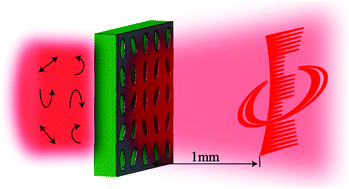Polarization-independent broadband meta-holograms via polarization-dependent nanoholes†
Abstract
Composed of ultrathin metal or dielectric nanostructures, metasurfaces can manipulate the phase, amplitude and polarization of electromagnetic waves at a subwavelength scale, which is promising for flat optical devices. In general, metasurfaces composed of space-variant anisotropic units are sensitive to the incident polarization due to the inherent polarization dependent geometric phase. Here, we implement polarization-independent broadband metasurface holograms constructed by polarization-dependent anisotropic elliptical nanoholes by elaborate design of complex amplitude holograms. The fabricated meta-hologram exhibits a polarization insensitive feature with an acceptable image quality. We verify the feasibility of the design algorithm for three-dimensional (3D) meta-holograms with simulation and the feasibility for two-dimensional (2D) meta-holograms is experimentally demonstrated at a broadband wavelength range from 405 nm to 632.8 nm. The effective polarization-independent broadband complex wavefront control with anisotropic elliptical nanoholes proposed in this paper greatly promotes the practical applications of the metasurface in technologies associated with wavefront manipulation, such as flat lens, colorful holographic displays and optical storage.



 Please wait while we load your content...
Please wait while we load your content...